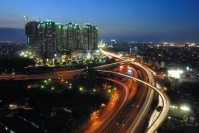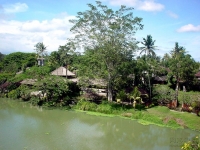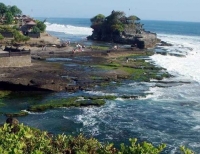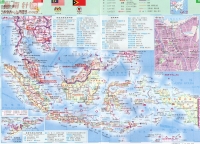東南亞:
|
| 印度尼西亞 Indonesia 首都:雅加達 国家代码: id |
|
印度尼西亞共和國(The Republic of Indonesia)
獨立日:8月17日(1945年) 國慶日:8月17日(1945年) 國旗:旗由上紅下白兩個相等的橫長方形構成,長與寬之比為3∶2。紅色象徵勇敢和正義,還象徵印度尼西亞獨立以的繁榮昌盛;白色象徵自由、公正、純潔,還達印尼人民反對侵略、愛好和平的美好願望。 國徽: 由一隻金色的鷹、一面盾和鷹爪抓着的一條綬帶組成。鷹象徵創造力。鷹兩翼各有17根羽毛,尾羽8根,這是為紀念印度尼西亞的獨立日——8月17日。鷹胸前的盾由五部分組成:黑色小盾和金黃色的五角星代宗教信仰,也象徵“潘查希拉”——印尼建國的五項基本原則;水牛頭象徵主權屬於人民;榕樹象徵民族意識;棉桃和稻穗象徵富足和公正;金色飾環象徵人道主義和世代相傳。盾上的粗黑綫代赤道。鷹爪抓着的綬帶上用印尼文寫着“異中有同”。 國政要:總統西洛·班邦·尤多約諾(Susilo Bambang Yudhoyono),2004年10月當選;副總統優素福·卡拉,2004年10月當選;人協主席希達亞特·努爾·瓦希德 ,2004年10月當選。 自然地理:位於亞洲東南部,地跨赤道,是世界上最大的群島國,由太平洋和印度洋之間17508個大小島嶼組成,其中約6000個有人居住。陸地面積為1,904,443平方公,海洋積3,166,163平方公(不包括專屬經濟區)素稱島之國。北部的加曼丹島與馬來西亞接壤,新內亞島與巴亞新內亞相連。東北部面臨菲律賓,東南部是印度洋,西南與澳大利亞相望。海岸綫總長54716公。熱帶雨林氣候,年平均溫度25-27℃。 人口:2.17億(2004年),為世界第四人口大國。有100多個民族,其中爪哇族占45%,巽他族占14%,馬都拉族7.5%,馬來族7.5%,其他26%。官方語言為印度尼西亞語。民族語言和方言約300。約87%的居民信奉伊斯蘭教,是世界上穆斯林人口最多的國,6. 1%的人口信奉基督教新教,3. 6%信奉天主教,其餘信奉印度教、佛教和原始拜物教等。 首都:雅加達(Jakarta),位於爪哇島上;人口有838.5萬(2000年)。 行政區: 共有一級行政區30個,包括雅加達首都特區,日惹和亞齊達魯薩蘭2個地方特區,27個省即北門答臘、西門答臘、廖內、占碑、朋古魯、南門答臘、楠榜、邦加-勿洞、西爪哇、中爪哇、東爪哇、萬丹、巴釐、西努沙登加拉、東努沙登加拉、北馬魯古、南馬魯古、巴亞、北拉威西、中拉威西、東南拉威西、南拉威西、哥倫打洛、東加曼丹 、中加曼丹、南加曼丹、西加曼丹。二級行政區(縣/市)410個。 簡史:公元3-7世紀建立一些分散的封建王國。13世紀末至14世紀初,在爪哇建立印尼歷史上最強大的麻喏巴歇封建帝國。15世紀,葡萄牙、西班牙和英國先侵入。1596年荷蘭侵入,1602年成立具有政府職權的“東印度公司”,1799年底改設殖民政府。1942年日本占領印尼,1945年日本投降,印尼爆八月革命,8月17日宣佈獨立,成立印度尼西亞共和國。1947年,荷蘭與印尼經過多次戰爭和協商,於1949年11月簽訂印荷《圓桌會議協定》。根此協定,印尼於同年12月27日成立聯邦共和國,參加荷印聯邦。1950年8月印尼聯邦議院通過臨時憲法,正式宣佈成立印度尼西亞共和國。 政治:實行總統內閣。人民協商會議是國最高權力機構,負責定、修改與頒憲法和國總方針政策,選舉總統,副總統(2004年改由全民直選),監督和評價總統執行國大政方針情況和在總統違背憲法時對其進行彈劾或罷免。設中央一級。成員700名,任期5年。國會(全稱人民代會議)是國立法機構,行使修憲和定國大政方針之外的一般立法權。國會無權解除總統職務,總統也不能宣佈解散國會;但如總統違反憲法或人協决議,國會有權建議人協追究總統責任。共有議員500名,兼任人協成員。任期5年。總統是國元首、政府行政首腦和武裝部隊最高統帥,直接領導內閣,有權單獨頒政令和宣佈國緊急狀態法令;對外宣戰或媾和等。自2004年起,總統和副總統不再由人民協商會議選舉産生,改由全民直選;能連選連任一次,每任五年。總統任命內閣,但需得國會同意。 經濟:印尼是東盟最大的經濟。農業、工業和服務業均在國民經濟中揮重要作用,其中農業和油氣産業傳統支柱産業。印尼資源豐富,礦産主要有石油、天然氣、煤、錫、鋁礬土、鎳、銅和金、銀等。已探明礦産儲量為:石油51.2億桶、天然氣94.75萬億立方尺,是世界著名的液化天然氣出口國、煤360億噸,亞太地區重要的産煤國和世界煤炭出口國。地熱資源豐富,橡膠和椰子産量居世界第2位,棕櫚油産量占世界需求量的2/5。森林積為1.45億公頃,占國土積的74%。印尼工業展的方向是加強外型的製造業,主要部門有製造、礦、紡織、輕工、加工業等。農業是印尼的支柱産業,包括從事林業和漁業人口在內,全國農業人口約占總人口的59%。耕地面積5980萬公頃(不包括巴亞省)。印尼重視旅遊業,旅遊業已成為印尼創的主要行業。主要旅遊點有巴釐島、婆羅浮屠佛塔、印尼縮影公園、日惹皇宮、多巴湖等。印尼還是一個火山之國,共有400多座火山,其中活火山100多座。 貨幣:盧比(盾)>>> 新聞出版:主要印尼文報紙有《羅盤報》、《專業之聲報》、《印尼媒報》、《共和國日報等》、《革新之聲報》和《印尼商報》;英文報紙有《雅加達郵報》、《印尼觀察報》等;中文報紙原來衹有政府主辦的《印度尼西亞日報》,近兩年新創建的有《華文郵報》(中文和印尼文互譯)、《商報》、《新生日報》、《島日報》等。1937年成立的安塔拉通訊社是官方通訊社,1967年成立的印尼民族通訊社為私營機構,成立於1945年9月的印尼共和國播電是國電,1962年8月17日正式運營的印尼共和國電視為國電視,私營電視有1988年11月14日建立的印尼鷹記電視、1990年8月成立的太陽電視,和1991年1月組建的教育電視,2000年10月開設的美都電視是印尼首新聞電視,開創播放中文新聞的先例。 外交:奉行獨立自主、不結盟的積極外交政策,主張平等、相互尊重和大國平衡原則,積極參與國際和地區事務。 與中國關係:1950年4月13日,印度尼西亞同中國建交。1990年8月8日,兩國恢外交關係。1994年11月,國主席江澤民對印尼進行國事訪問。1999年12月,印尼總統瓦希德對中國進行國事訪問。2000年5月,中國與印尼在北京正式簽署《中華人民共和國和印度尼西亞共和國關於未來雙邊作方向的聯聲明》。2002年3月,梅加瓦蒂總統對中國進行國事訪問。2005年4月13日,中國國主席錦濤與印尼總統西洛·班邦·尤多約諾近日互賀電,祝賀兩國建交55周年(4月13日)。 The Indonesian archipelago has been an important trade region since at least the seventh century, when the Srivijaya Kingdom formed trade links with China. Indonesian history has been influenced by foreign powers drawn to its natural resources. Under Indian influence, Hindu and Buddhist kingdoms flourished from the early centuries CE. Muslim traders brought Islam, and European powers fought one another to monopolize trade in the Spice Islands of Maluku during the Age of Discovery. Following three and a half centuries of Dutch colonialism, Indonesia secured its independence after World War II. Indonesia's history has since been turbulent, with challenges posed by natural disasters, corruption, separatism, a democratization process, and periods of rapid economic change. Across its many islands, Indonesia consists of distinct ethnic, linguistic, and religious groups. The Javanese are the largest and most politically dominant ethnic group. As a unitary state and a nation, Indonesia has developed a shared identity defined by a national language, a majority Muslim population, and a history of colonialism and rebellion against it. Indonesia's national motto, "Bhinneka tunggal ika" ("Unity in Diversity" lit. "many, yet one"), articulates the diversity that shapes the country. However, sectarian tensions and separatism have led to violent confrontations that have undermined political and economic stability. Despite its large population and densely populated regions, Indonesia has vast areas of wilderness that support the world's second highest level of biodiversity. The country is richly endowed with natural resources, yet poverty is a defining feature of contemporary Indonesia. The name Indonesia derives from the Latin Indus, meaning "India", and the Greek nesos, meaning "island". The name dates to the 18th century, far predating the formation of independent Indonesia. In 1850, George Earl, an English ethnologist, proposed the terms Indunesians — and, his preference, Malayunesians — for the inhabitants of the "Indian Archipelago or Malayan Archipelago". In the same publication, a student of Earl's, James Richardson Logan, used Indonesia as a synonym for Indian Archipelago. However, Dutch academics writing in East Indies publications were reluctant to use Indonesia. Instead, they used the terms Malay Archipelago (Maleische Archipel); the Netherlands East Indies (Nederlandsch Oost Indië), popularly Indië; the East (de Oost); and even Insulinde. From 1900, the name Indonesia became more common in academic circles outside the Netherlands, and Indonesian nationalist groups adopted it for political expression. Adolf Bastian, of the University of Berlin, popularized the name through his book Indonesien oder die Inseln des Malayischen Archipels, 1884–1894. The first Indonesian scholar to use the name was Suwardi Suryaningrat (Ki Hajar Dewantara), when he established a press bureau in the Netherlands with the name Indonesisch Pers-bureau in 1913. History As early as the first century CE Indonesian vessels made trade voyages as far as Africa. Picture: a ship carved on Borobudur, circa 800 CE.Fossilized remains of Homo erectus, popularly known as the "Java Man", suggest that the Indonesian archipelago was inhabited two million to 500,000 years ago. Austronesian people, who form the majority of the modern population, migrated to South East Asia from Taiwan. They arrived in Indonesia around 2000 BCE, and confined the native Melanesian peoples to the far eastern regions as they expanded. Ideal agricultural conditions, and the mastering of wet-field rice cultivation as early as the eighth century BCE, allowed villages, towns, and small kingdoms to flourish by the first century CE. Indonesia's strategic sea-lane position fostered inter-island and international trade. For example, trade links with both Indian kingdoms and China were established several centuries BCE. Trade has since fundamentally shaped Indonesian history. The nutmeg plant is native to Indonesia's Banda Islands. Once one of the world's most valuable commodities, it drew the first European colonial powers to Indonesia.From the seventh century CE, the powerful Srivijaya naval kingdom flourished as a result of trade and the influences of Hinduism and Buddhism that were imported with it. Between the eighth and 10th centuries CE, the agricultural Buddhist Sailendra and Hindu Mataram dynasties thrived and declined in inland Java, leaving grand religious monuments such as Sailendra's Borobudur and Mataram's Prambanan. The Hindu Majapahit kingdom was founded in eastern Java in the late 13th century, and under Gajah Mada, its influence stretched over much of Indonesia; this period is often referred to as a "Golden Age" in Indonesian history. Although Muslim traders first traveled through South East Asia early in the Islamic era, the earliest evidence of Islamized populations in Indonesia dates to the 13th century in northern Sumatra. Other Indonesian areas gradually adopted Islam, and it was the dominant religion in Java and Sumatra by the end of the 16th century. For the most part, Islam overlaid and mixed with existing cultural and religious influences, which shaped the predominant form of Islam in Indonesia, particularly in Java. The first Europeans arrived in Indonesia in 1512, when Portuguese traders, led by Francisco Serrão, sought to monopolize the sources of nutmeg, cloves, and cubeb pepper in Maluku. Dutch and British traders followed. In 1602 the Dutch established the Dutch East India Company (VOC) and became the dominant European power. Following bankruptcy, the VOC was formally dissolved in 1800, and the government of the Netherlands established the Dutch East Indies as a nationalized colony. For most of the colonial period, Dutch control over these territories was tenuous; only in the early 20th century did Dutch dominance extend to what was to become Indonesia's current boundaries. The Japanese invasion and subsequent occupation during World War II ended Dutch rule, and encouraged the previously suppressed Indonesian independence movement. Two days after the surrender of Japan in August 1945, Sukarno, an influential nationalist leader, declared independence and was appointed president. The Netherlands tried to reestablish their rule, and an armed and diplomatic struggle ended in December 1949, when in the face of international pressure, the Dutch formally recognized Indonesian independence (with the exception of The Dutch territory of West New Guinea, which was incorporated following the 1962 New York Agreement, and UN—mandated Act of Free Choice). Sukarno, Indonesia's founding presidentSukarno moved from democracy towards authoritarianism, and maintained his power base by balancing the opposing forces of the Military, Islam, and the Communist Party of Indonesia (PKI). An attempted coup on 30 September 1965 was countered by the army, who led a violent anti-communist purge, during which the PKI was blamed for the coup and effectively destroyed. Between 500,000 and one million people were killed. The head of the military, General Suharto, out-maneuvered the politically weakened Sukarno, and was formally appointed president in March 1968. His New Order administration was supported by the US government, and encouraged foreign direct investment in Indonesia, which was a major factor in the subsequent three decades of substantial economic growth. However, the authoritarian "New Order" was widely accused of corruption and suppression of political opposition. In 1997 and 1998, Indonesia was the country hardest hit by the Asian Financial Crisis. This increased popular discontent with the New Order and led to popular protests. Suharto resigned on 21 May 1998. In 1999, East Timor voted to secede from Indonesia, after a twenty-five-year military occupation that was marked by international condemnation of often brutal repression of the East Timorese. The Reformasi era following Suharto's resignation, has led to a strengthening of democratic processes, including a regional autonomy program, and the first direct presidential election in 2004. Political and economic instability, social unrest, corruption, and terrorism have slowed progress. Although relations among different religious and ethnic groups are largely harmonious, acute sectarian discontent and violence remain problems in some areas. A political settlement to an armed separatist conflict in Aceh was achieved in 2005. Government and politics Indonesia is a republic with a presidential system. As a unitary state, power is concentrated in the national government. Following the resignation of President Suharto in 1998, Indonesian political and governmental structures have undergone major reforms. Four amendments to the 1945 Constitution of Indonesia have revamped the executive, judicial, and legislative branches. The president of Indonesia is the head of state, commander-in-chief of the Indonesian Armed Forces, and the director of domestic governance, policy-making, and foreign affairs. The president appoints a council of ministers, who are not required to be elected members of the legislature. The 2004 presidential election was the first in which the people directly elected the president and vice president. The president may serve a maximum of two consecutive five-year terms. A session of the People's Representative Council in JakartaThe highest representative body at national level is the People's Consultative Assembly (MPR). Its main functions are supporting and amending the constitution, inaugurating the president, and formalizing broad outlines of state policy. It has the power to impeach the president. The MPR comprises two houses; the People's Representative Council (DPR), with 550 members, and the Regional Representatives Council (DPD), with 168 members. The DPR passes legislation and monitors the executive branch; party-aligned members are elected for five-year terms by proportional representation. Reforms since 1998 have markedly increased the DPR's role in national governance. The DPD is a new chamber for matters of regional management. Most civil disputes appear before a State Court; appeals are heard before the High Court. The Supreme Court is the country's highest court, and hears final cassation appeals and conducts case reviews. Other courts include the Commercial Court, which handles bankruptcy and insolvency; a State Administrative Court to hear administrative law cases against the government; a Constitutional Court to hear disputes concerning legality of law, general elections, dissolution of political parties, and the scope of authority of state institutions; and a Religious Court to deal with specific religious cases. Foreign relations and military In contrast to Sukarno's anti-imperialistic antipathy to western powers and tensions with Malaysia, Indonesia's foreign relations since the Suharto "New Order" have been based on economic and political cooperation with Western nations. Indonesia maintains close relationships with its neighbors in Asia, and is a founding member of ASEAN and the East Asia Summit. The nation restored relations with the People's Republic of China in 1990 following a freeze in place since anti-communist purges early in the Suharto era. Indonesia has been a member of the United Nations since 1950, and was a founder of the Non-Aligned Movement (NAM) and the Organisation of the Islamic Conference (OIC). Indonesia is signatory to the ASEAN Free Trade Area agreement, and a member of OPEC, the Cairns Group, and the WTO. Indonesia has received humanitarian and development aid since 1966, in particular from the United States, western Europe, Australia, and Japan. National flags at the site of the 2002 terrorist bombing in Kuta, BaliThe Indonesian Government has worked with other countries to apprehend and prosecute perpetrators of major bombings linked to militant Islamism and Al-Qaeda. The deadliest killed 202 people (including 164 international tourists) in the Bali resort town of Kuta in 2002. The attacks, and subsequent travel warnings issued by other countries, severely damaged Indonesia's tourism industry and foreign investment prospects. Indonesia's 300,000-member armed forces (TNI) include the Army (TNI-AD), Navy (TNI-AL, which includes marines), and Air Force (TNI-AU). The army has about 233,000 active-duty personnel. Defense spending in the national budget was 4% of GDP in 2006, and is controversially supplemented by revenue from military commercial interests and foundations. In the post-Suharto period since 1998, formal TNI representation in parliament has been removed; though curtailed, its political influence remains extensive. Separatist movements in the provinces of Aceh and Papua have led to armed conflict, and subsequent allegations of human rights abuses and brutality from all sides. Following a sporadic thirty year guerrilla war between the Free Aceh Movement (GAM) and the Indonesian military, a ceasefire agreement was reached in 2005. In Papua, there has been a significant, albeit imperfect, implementation of regional autonomy laws, and a reported decline in the levels of violence and human rights abuses, since the presidency of Susilo Bambang Yudhoyono. Administrative divisions Provinces of IndonesiaAdministratively, Indonesia consists of 33 provinces, five of which have special status. Each province has its own political legislature and governor. The provinces are subdivided into regencies (kabupaten) and cities (kota), which are further subdivided into subdistricts (kecamatan), and again into village groupings (either desa or kelurahan). Following the implementation of regional autonomy measures in 2001, the regencies and cities have become the key administrative units, responsible for providing most government services. The village administration level is the most influential on a citizen's daily life, and handles matters of a village or neighborhood through an elected lurah or kepala desa (village chief). The provinces of Aceh, Jakarta, Yogyakarta, Papua, and West Papua have greater legislative privileges and a higher degree of autonomy from the central government than the other provinces. The Acehnese government, for example, has the right to create an independent legal system; in 2003, it instituted a form of Sharia (Islamic law). Yogyakarta was granted the status of Special Region in recognition of its pivotal role in supporting Indonesian Republicans during the Indonesian Revolution. Papua, formerly known as Irian Jaya, was granted special autonomy status in 2001. Jakarta is the country's special capital region. Indonesian provinces and their capitals (Indonesian name in brackets where different from English) † indicates provinces with Special Status Sumatra Aceh† (Nanggroe Aceh Darussalam) - Banda Aceh North Sumatra (Sumatera Utara) - Medan West Sumatra (Sumatera Barat) - Padang Riau - Pekanbaru Riau Islands (Kepulauan Riau) - Tanjung Pinang Jambi - Jambi (city) South Sumatra (Sumatera Selatan) - Palembang Bangka-Belitung (Kepulauan Bangka-Belitung) - Pangkal Pinang Bengkulu - Bengkulu (city) Lampung - Bandar Lampung Java Jakarta† - Jakarta Banten - Serang West Java (Jawa Barat) - Bandung Central Java (Jawa Tengah) - Semarang Yogyakarta Special Region† - Yogyakarta (city) East Java (Jawa Timur) - Surabaya Lesser Sunda Islands Bali - Denpasar West Nusa Tenggara (Nusa Tenggara Barat) - Mataram East Nusa Tenggara (Nusa Tenggara Timur) - Kupang Kalimantan West Kalimantan (Kalimantan Barat) - Pontianak Central Kalimantan (Kalimantan Tengah) - Palangkaraya South Kalimantan (Kalimantan Selatan) - Banjarmasin East Kalimantan (Kalimantan Timur) - Samarinda Sulawesi North Sulawesi (Sulawesi Utara) - Manado Gorontalo - Gorontalo (city) Central Sulawesi (Sulawesi Tengah) - Palu West Sulawesi (Sulawesi Barat) - Mamuju South Sulawesi (Sulawesi Selatan) - Makassar South East Sulawesi (Sulawesi Tenggara) - Kendari Maluku Islands Maluku - Ambon North Maluku (Maluku Utara) - Ternate Papua West Papua† (Papua Barat) - Manokwari Papua† - Jayapura Geography Map of IndonesiaIndonesia consists of 17,508 islands, about 6,000 of which are inhabited. These are scattered over both sides of the equator. The five largest islands are Java, Sumatra, Kalimantan (the Indonesian part of Borneo), New Guinea (shared with Papua New Guinea), and Sulawesi. Indonesia shares land borders with Malaysia on the islands of Borneo and Sebatik, Papua New Guinea on the island of New Guinea, and East Timor on the island of Timor. Indonesia also shares borders with Singapore, Malaysia, and the Philippines to the north and Australia to the south across narrow straits of water. The capital, Jakarta, is on Java and is the nation's largest city, followed by Surabaya, Bandung, Medan, and Semarang. At 1,919,440 square kilometers (741,050 sq mi), Indonesia is the world's 16th-largest country in terms of land area. Its average population density is 134 people per square kilometer (347 per sq mi), 79th in the world, although Java, the world's most populous island, has a population density of 940 people per square kilometer (2,435 per sq mi). At 4,884 meters (16,024 ft), Puncak Jaya in Papua is Indonesia's highest peak, and Lake Toba in Sumatra its largest lake, with an area of 1,145 square kilometers (442 sq mi). The country's largest rivers are in Kalimantan, and include the Mahakam and Barito; such rivers are communication and transport links between the island's river settlements. Mount Semeru and Mount Bromo in East Java. Indonesia's seismic and volcanic activity is among the world's highest.Indonesia's location on the edges of the Pacific, Eurasian, and Australian tectonic plates makes it the site of numerous volcanoes and frequent earthquakes. Indonesia has at least 150 active volcanoes, including Krakatoa and Tambora, both famous for their devastating eruptions in the 19th century. The eruption of the Toba supervolcano, approximately 70,000 years ago, was one of the largest eruptions ever, and a global catastrophe. Recent disasters due to seismic activity include the 2004 tsunami that killed an estimated 167,736 in northern Sumatra, and the Yogyakarta earthquake in 2006. However, volcanic ash is a major contributor to the high agricultural fertility that has historically sustained the high population densities of Java and Bali. Lying along the equator, Indonesia has a tropical climate, with two distinct monsoonal wet and dry seasons. Average annual rainfall in the lowlands varies from 1,780–3,175 millimeters (70–125 in), and up to 6,100 millimeters (240 in) in mountainous regions. Mountainous areas—particularly in the west coast of Sumatra, West Java, Kalimantan, Sulawesi, and Papua—receive the highest rainfall. Humidity is generally high, averaging about 80%. Temperatures vary little throughout the year; the average daily temperature range of Jakarta is 26–30 °C (79–86 °F). Ecology The critically endangered Sumatran Orangutan, a great ape endemic to IndonesiaIndonesia's size, tropical climate, and archipelagic geography, support the world's second highest level of biodiversity (after Brazil), and its flora and fauna is a mixture of Asian and Australasian species. Once linked to the Asian mainland, the islands of the Sunda Shelf (Sumatra, Java, Borneo, and Bali) have a wealth of Asian fauna. Large species such as the tiger, rhinoceros, orangutan, elephant, and leopard, were once abundant as far east as Bali, but numbers and distribution have dwindled drastically. Forests cover approximately 60% of the country. In Sumatra and Kalimantan, these are predominantly of Asian species. However, the forests of the smaller, and more densely populated Java, have largely been removed for human habitation and agriculture. Sulawesi, Nusa Tenggara, and Maluku—having been long separated from the continental landmasses—have developed their own unique flora and fauna. Papua was part of the Australian landmass, and is home to a unique fauna and flora closely related to that of Australia, including over 600 bird species. Orchid Cymbidium dayanumIndonesia is second only to Australia in its degree of endemism, with 26% of its 1,531 species of bird and 39% of its 515 species of mammal being endemic. Indonesia's 80,000 kilometers (50,000 mi) of coastline are surrounded by tropical seas that contribute to the country's high level of biodiversity. Indonesia has a range of sea and coastal ecosystems, including beaches, sand dunes, estuaries, mangroves, coral reefs, sea grass beds, coastal mudflats, tidal flats, algal beds, and small island ecosystems. The British naturalist, Alfred Wallace, described a dividing line between the distribution of Indonesia's Asian and Australasian species. Known as the Wallace Line, it runs roughly north-south along the edge of the Sunda Shelf, between Kalimantan and Sulawesi, and along the deep Lombok Strait, between Lombok and Bali. West of the line the flora and fauna are more Asian; moving east from Lombok, they are increasingly Australian. In his 1869 book, The Malay Archipelago, Wallace described numerous species unique to the surrounding area, which is now termed Wallacea. Indonesia's high population and rapid industrialization present serious environmental issues, which are often given a lower priority due to high poverty levels and weak, under-resourced governance. Issues include large-scale deforestation (much of it illegal) and related wildfires causing heavy smog over parts of western Indonesia, Malaysia and Singapore; over-exploitation of marine resources; and environmental problems associated with rapid urbanization and economic development, including air pollution, traffic congestion, garbage management, and reliable water and waste water services. Habitat destruction threatens the survival of indigenous and endemic species, including 140 species of mammals identified by the World Conservation Union (IUCN) as threatened, and 15 identified as critically endangered, including the Sumatran Orangutan. Economy Using water buffalo to plough rice fields in Java. Agriculture has been the country's largest employer for centuries.Indonesia's estimated Gross Domestic Product (GDP) for 2007 is US$408 billion (US$1,038 bn PPP). In 2007, estimated nominal per capita GDP is US$1,812, and per capita GDP PPP was US$4,616 (International Dollars). The services sector is the economy's largest and accounts for 45.3% of GDP (2005). This is followed by industry (40.7%) and agriculture (14.0%). However, agriculture employs more people than other sectors, accounting for 44.3% of the 95 million-strong workforce. This is followed by the services sector (36.9%) and industry (18.8%). Major industries include petroleum and natural gas, textiles, apparel, and mining. Major agricultural products include palm oil, rice, tea, coffee, spices, and rubber. Indonesia's main export markets (2005) are Japan (22.3%), the United States (13.9%), China (9.1%), and Singapore (8.9%). The major suppliers of imports to Indonesia are Japan (18.0%), China (16.1%), and Singapore (12.8%). In 2005, Indonesia ran a trade surplus with export revenues of US$83.64 billion and import expenditure of US$62.02 billion. The country has extensive natural resources, including crude oil, natural gas, tin, copper, and gold. Indonesia's major imports include machinery and equipment, chemicals, fuels, and foodstuffs. Jakarta, the capital of Indonesia and the country's largest commercial centerIn the 1960s, the economy deteriorated drastically as a result of political instability, a young and inexperienced government, and ill-disciplined economic nationalism, which resulted in severe poverty and hunger. Following President Sukarno's downfall in the mid-1960s, the New Order administration brought a degree of discipline to economic policy that quickly brought inflation down, stabilized the currency, rescheduled foreign debt, and attracted foreign aid and investment. Indonesia is Southeast Asia's only member of OPEC, and the 1970s oil price raises provided an export revenue windfall that contributed to sustained high economic growth rates. Following further reforms in the late 1980s, foreign investment flowed into Indonesia, particularly into the rapidly developing export-oriented manufacturing sector, and from 1989 to 1997, the Indonesian economy grew by an average of over 7%. Indonesia was the country hardest hit by the East Asian financial crisis of 1997–98. Against the US dollar, the currency dropped from about Rp. 2,000 to Rp. 18,000, and the economy shrunk by 13.7%. The rupiah has since stabilized at around Rp. 10,000, and there has been a slow but significant economic recovery. Political instability since 1998, slow economic reform, and corruption at all levels of government and business, have contributed to the patchy nature of the recovery. (Transparency International, for example, ranked Indonesia 143rd out of 180 countries in its 2007 Corruption Perceptions Index). GDP growth, however, exceeded 5% in both 2004 and 2005, and is forecast to increase further. This growth rate, however, is not enough to make a significant impact on unemployment, and stagnant wages growth, and increases in fuel and rice prices have worsened poverty levels. As of 2006, an estimated 17.8% of the population live below the poverty line, 49.0% of the population live on less than US$2 per day, and unemployment rate at 9.75%. Demographics The national population from the 2000 national census is 206 million, and the Indonesian Central Statistics Bureau and Statistics Indonesia estimate a population of 222 million for 2006. 130 million people live on the island of Java, the world's most populous island. Despite a fairly effective family planning program that has been in place since the 1960s, the population is expected to grow to around 315 million by 2035, based on the current estimated annual growth rate of 1.25%. A Minangkabau woman in traditional dressMost Indonesians are descendant from Austronesian-speaking peoples who originated from Taiwan. The other major grouping are Melanesians, who inhabit eastern Indonesia. There are around 300 distinct native ethnicities in Indonesia, and 742 different languages and dialects. The largest is the Javanese, who comprise 42% of the population, and are politically and culturally dominant. The Sundanese, ethnic Malays, and Madurese are the largest non-Javanese groups. A sense of Indonesian nationhood exists alongside strongly maintained regional identities. Society is largely harmonious, although social, religious and ethnic tensions have triggered horrendous violence. Chinese Indonesians are an influential ethnic minority comprising less than 2% of the population. Much of the country's privately-owned commerce and wealth is Chinese-controlled, which has contributed to considerable resentment, and even anti-Chinese violence. The official national language, Indonesian, is universally taught in schools, and is spoken by nearly every Indonesian. It is the language of business, politics, national media, education, and academia. It was originally a lingua franca for most of the region, including present-day Malaysia, and is thus closely related to Malay. Indonesian was first promoted by nationalists in the 1920s, and declared the official language on independence in 1945. Most Indonesians speak at least one of the several hundred local languages (bahasa daerah), often as their first language. Of these, Javanese is the most widely-spoken as the language of the largest ethnic group. On the other hand, Papua has 500 or more indigenous Papuan and Austronesian languages, in a region of just 2.7 million people. Much of the older population can still speak a level of Dutch. Medan's Masjid Raya ('Great Mosque'). Indonesia has the world's largest Muslim population.Although religious freedom is stipulated in the Indonesian constitution, the government officially recognizes only six religions: Islam; Protestantism; Roman Catholicism; Hinduism; Buddhism; and Confucianism. Although it is not an Islamic state, Indonesia is the world's most populous Muslim-majority nation, with almost 86% of Indonesians declared Muslim according to the 2000 census. 11% of the population is Christian, 2% are Hindu, and 1% Buddhist. Most Indonesian Hindus are Balinese, and most Buddhists in modern-day Indonesia are ethnic Chinese. Though now minority religions, Hinduism and Buddhism remain defining influences in Indonesian culture. Islam was first adopted by Indonesians in northern Sumatra in the 13th century, through the influence of traders, and became the country's dominant religion by the 16th century. Roman Catholicism was brought to Indonesia by early Portuguese colonialists and missionaries, and the Protestant denominations are largely a result of Dutch Calvinist and Lutheran missionary efforts during the country's colonial period. A large proportion of Indonesians—such as the Javanese abangan, Balinese Hindus, and Dayak Christians—practice a less orthodox, syncretic form of their religion, which draws on local customs and beliefs. Culture A Wayang kulit shadow puppet performance as seen by the audienceIndonesia has around 300 ethnic groups, each with cultural differences developed over centuries, and influenced by Indian, Arabic, Chinese, Malay, and European sources. Traditional Javanese and Balinese dances, for example, contain aspects of Hindu culture and mythology, as do wayang kulit (shadow puppet) performances. Textiles such as batik, ikat and songket are created across Indonesia in styles that vary by region. The most dominant influences on Indonesian architecture have traditionally been Indian; however, Chinese, Arab, and European architectural influences have been significant. The most popular sports in Indonesia are badminton and football; Liga Indonesia is the country's premier football club league. Traditional sports include sepak takraw, and bull racing in Madura. In areas with a history of tribal warfare, mock fighting contests are held, such as, caci in Flores, and pasola in Sumba. Pencak Silat is an Indonesian martial art. Sports in Indonesia are generally male-orientated and spectator sports are often associated with illegal gambling. A selection of Indonesian food, including Soto Ayam (chicken noodle soup), sate kerang (shellfish kebabs), telor pindang (preserved eggs), perkedel (fritter), and es teh manis (sweet iced tea)Indonesian cuisine varies by region and is based on Chinese, European, Middle Eastern, and Indian precedents. Rice is the main staple food and is served with side dishes of meat and vegetables. Spices (notably chili), coconut milk, fish and chicken are fundamental ingredients. Indonesian traditional music includes gamelan and keroncong. Dangdut is a popular contemporary genre of pop music that draws influence from Arabic, Indian, and Malay folk music. The Indonesian film industry's popularity peaked in the 1980s and dominated cinemas in Indonesia, although it declined significantly in the early 1990s. Between 2000 and 2005, the number of Indonesian films released each year has steadily increased. The oldest evidence of writing in Indonesia is a series of Sanskrit inscriptions dated to the 5th century CE. Important figures in modern Indonesian literature include: Dutch author Multatuli, who criticized treatment of the Indonesians under Dutch colonial rule; Sumatrans Muhammad Yamin and Hamka, who were influential pre-independence nationalist writers and politicians; and proletarian writer Pramoedya Ananta Toer, Indonesia's most famous novelist. Many of Indonesia's peoples have strongly-rooted oral traditions, which help to define and preserve their cultural identities. Media freedom in Indonesia increased considerably after the end of President Suharto's rule, during which the now-defunct Ministry of Information monitored and controlled domestic media, and restricted foreign media. The TV market includes ten national commercial networks, and provincial networks that compete with public TVRI. Private radio stations carry their own news bulletins and foreign broadcasters supply programs. At a reported 20 million users in 2007, Internet usage is limited to a minority of the population, approximately 8.5%. |
|
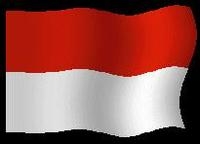
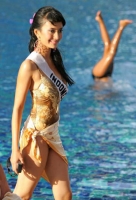
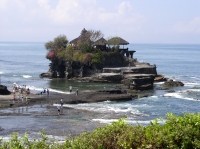
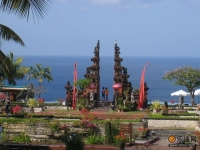
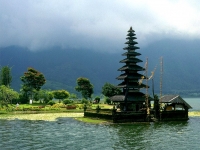

![旅游]异域风情的印度尼西亚--生活之友 风光旑旎的印度尼西亚
点击图片查看详情](http://oson.ca/upload/images11/cache/02405e15306906b62d7677065ccb9b7e.jpg)
